If we follow the curves of the roads, we can reach places that still seem untouched by human, where silence and the hissing of the wind reign. It is hard to believe that an island, within its intimacy, can contain so many amazing things to find out.
The most hidden part of the island of nuraghi offers an unusual and unpredictable beauty. When we wonder about what to do and see in Sardinia, everyone recommends visiting its beaches, among the best in the world, but it is not enough to stop there: there are also incredible places and villages to discover full of surprises.
Ogliastra stands out among these, a sub-region located in the central-eastern area of Sardinia; and Ulassai appears here, almost like a dream, immersed in rich and wild nature through mountains with strange conformations called Tacchi Ogliastrini.
In this article let's discover together what to do and see in Ulassai, a wonderful gem of Ogliastra to visit on your next trip to Sardinia!

As long as you have passions, you will not cease to discover the world.
What to do and see in Ulassai: a village to visit slowly in Ogliastra

The heart of Sardinia is made up of mountains and forests where the white of the rocks, the green of the vegetation and the blue of the sky meet, creating striking colour contrasts.
Here, somewhere in the province of Nuoro, the small village of Ulassai awaits you nestled between the great complex of the Tacco di Ulassai to the north and Monte Tisiddu to the south. Strolling through the hamlet, one has the feeling that time passes more slowly here than elsewhere. Who knows if he too stops to look at the incredible views that appear between the houses? What is certain is that the village is part of one of the five blue zones of the world, where life expectancy is higher than usual.
Ulassai is a little open-air museum, originated from the harmony between nature, town architecture and works of art. On a plateau overlooking the valley below, just outside the hamlet, is the old railway station, inside which there is now a relatively small but significant museum for Sardinia. The Stazione dell'Arte (Art Station) is a tribute to the multiform genius of Maria Lai and her works of contemporary art, to an extraordinary woman who was a pioneer of relational art.
Ulassai, a paradise for sustainable tourism
Let's switch from profane art to sacred art, now. In the territory of Ulassai, there is another place to which the inhabitants are very attached. The small rural church of Saint Barbara is a simple building in typical Sardinian style, built with local stone and granite. The Roman porticoes surrounding it are called is loggettas and have always welcomed pilgrims on the days of the Saint's celebrations, still the most heartfelt of the local community.
The feeling you get here is of being in a peaceful, solid and genuine place, far from the pomp but beautiful in its simplicity.
Ulassai seems almost like a land out of this world and, in a way, this is true. It has lived in isolation for much of its history. For millennia, these incredible landscapes have been experienced exclusively by the local community, and only a few years ago the village opened up to tourism. Holidaymakers and sports enthusiasts from various parts of Europe are starting to come here to see an extraordinary environmental heritage of rocks, waterfalls, and forests with their own eyes.
In fact, for nature lovers looking for a sustainable holiday, enthusiasts about outdoor sports like hiking and free climbing, the image of Paradise can't be much different from this!
What to do and see in Ulassai: hiking on Tacchi d'Ogliastra in Ulassai
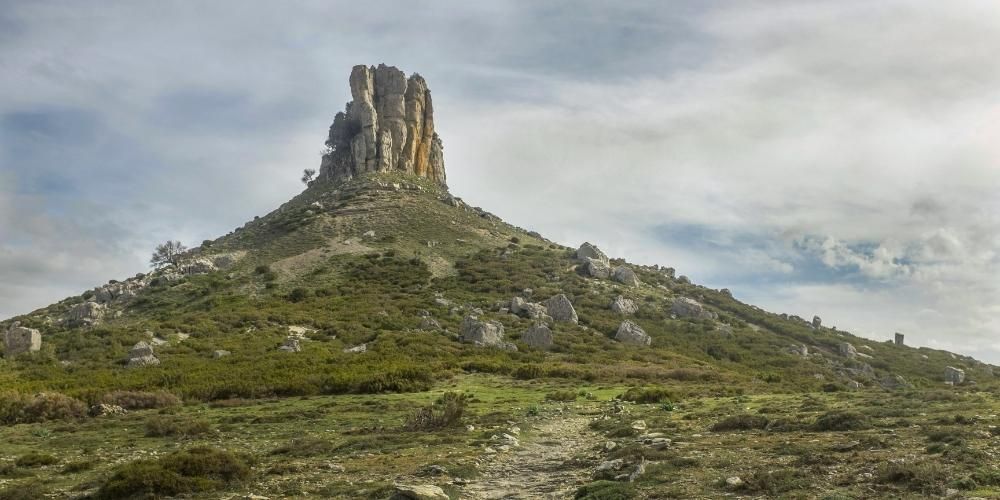
Imagine silence. And then a place unlike any other else. and yet, imagine the magic that permeates some of the most fascinating and wildest places all over Sardinia. What makes Ulassai a unique place in the world is the spectacular natural setting in which it is places, the scenery of the breathtaking Tacchi d'Ogliastra.
They are calcareous-dolomitic mountains with a shape similar to a shoe heel: blocks of rock with rough vertical walls that protrude forcefully from the earth. Above them are habitats with a valuable variety of animal and plant species and equally valuable endemic species, for example some specimens of birds of prey and wild plants that do not grow in the same way anywhere else.
For hiking and climbing enthusiasts, discovering these places is an experience not to be missed. Local guides and tour operators on the island arrange fantastic excursions all over the territory of Ulassai and Ogliastra where to discover the most secret paths, natural monuments and spectacular routes within the lush fantasy of nature here in the heart of Sardinia.
Life in Sardinia is perhaps the best a man can hope for: twenty-four thousand kilometres of forests, countryside and coastline immersed in a miraculous sea should coincide with what I would advise the good Lord to give us as a gift, Paradise.
Discovering a breathtaking landscape among waterfalls, caves and canyons
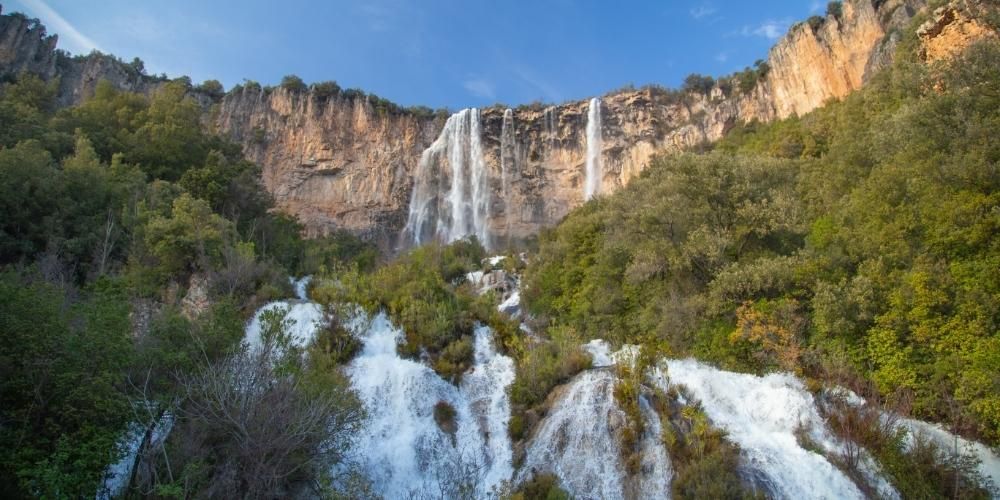
Speaking of what to do and see in Ulassai, and in particular the fundamental role of the natural landscape in this wonderful land, let's go on in our journey discovering some of its most beautiful and iconic places.
You can explore the territory of Ulassai in this way: step by step, paying attention to where you put your feet. Mother Nature, here, has protected her most precious works by hiding them among the mountains or even inside some of them. Among the evergreen forests of the Tacchi, a fauna protected by the Girisai wildlife oasis lives freely, and treasures such as caves and waterfalls lie here.
On the slopes of the Tacco, carved and shaped by time, there are spectacular caves, such as su Marmuri (‘the marble’) and is Lianas.
The caves of su Marmuri are among the most important in Europe for their size: 800 metres long and up to 70 metres high, beautiful and imposing as if they were the rooms of a secret palace carved into the mountain. The halls are all different, each with its name. The largest is the Grande Sala (Great Hall), which is rectangular and 72 metres long. Then there is the Sala del Cactus (Cactus Hall), with stalactites that resemble cacti, the Sala dei Pipistrelli (Bat Hall), the Sala dell'Organo (Organ Hall), the Galleria delle Vaschette (Tubs Gallery) and finally the Sala Terminale (Final Hall).
Just below, there is another magic of Ogliastra: the Lecorci waterfalls, just half a kilometre from the village. Subterranean waters gush out impetuously and whirl down vertical limestone walls, to join further downstream with the Lequarci waterfalls, the most imposing in Sardinia.
They jump almost 100 metres down, have a maximum width of 70 metres and, downstream, plunge into a lot of small lakes in the Santa Barbara area. If this is not enough, you can venture into a canyon tens of kilometres long, accompanied by the exciting flow of water: the stunning Gorge of sa Tappara.
Without resorting to geologists, who speak of a granite skeleton everywhere, without equal on the continent, similar to that of Corsica, those who arrive here immediately realise that they are facing a land they have never seen before.
Leaving from Ulassai discovering Sardinia's ancient history
In the territory of Ulassai as all over Sardinia, here and there appear the remains of an ancient civilisation: the Sardinian people who inhabited the island thousands of years ago and built truncated cone-shaped buildings made of large stones placed one on top of the other, so strong that they have remained up to present days.
More than 7000 nuraghi are found today in Sardinia, but there were probably many more. Other signs of the past are the Domus de Janas (fairy houses) and the Tombe dei Giganti (giants graves), buildings that have always fuelled popular imagination.
The island has a strong bond with its tradition. Even today, in some contexts, the sacred and the profane mix together, as do religiousness and magic. Archaeologists claim that the Domus de Janas and the Giants Graves were ancient burials of a people who began to honour their dead thousands of years ago. Popular culture, however, does not agree, and it seems that even today, in the dark of night, close to these archaeological wonders one can hear the faint sound of the looms of these creatures, part witch and part fairy, who weave tirelessly.
The most important Nuraghi in the area of Ulassai are the nuraghe s’Ulimu (1500-900 B.C.), consisting of two massive towers joined together, and the nuraghe Pranu, which has a single-tower structure. In addition to these, there are some Nuragic villages in the area and, near Nuraghe s’Ulimu, eight Domus de Janas, a Dolmen and three Giants’ Tombs.
Going west of Ulassai towards the very core of Sardinia it is possible to reach the famous Su Nuraxi di Barumini quite easily by car, probably the most famous and best preserved Nuragic village on the whole island. A truly unmissable experience if you don't want to miss the charm of the most remote and mystical past of the region!
Book your ticket for the park Sardinia in Miniature right next to the nuragic siteTaste and traditions in Ulassai: find out the most authentic side of Ogliastra

Before the advent of the railway in 1893, Ulassai was not connected with any place outside Ogliastra. This isolation has allowed it to keep its most ancient traditions intact, such as the horizontal loom, the particular technique of baking in wood-burning ovens (every house has one), costumes, dances and handmade food and wine production.
Let's start with flavors. The area's olive groves and vineyards produce olive oil and the renowned wine Cannonau, widespread throughout the island but whose primary production is in the province of Nuoro. Other delicacies include strawberry tree honey, artisan cheeses and hams and, among the typical dishes, culurgiones a ispighitta and coccoi prena: respectively, the symbol of Ogliastra's traditional cuisine, stuffed ravioli with potatoes, Sardinian pecorino cheese and mint, sealed with the typical closure that resembles an ear of corn; and a tasty stuffed focaccia that shepherds used to take with them when they took their animals out to pasture.
For what concerns ancient traditions, in Sardinia, perhaps even since prehistoric times, there are customs similar to Halloween that in Ulassai are called ‘is animeddas’. The festival's name varies in different parts of the island, but the traditional quest of the children is the same: they go around the streets of the villages and knock on doors reciting rhymes to ask for an offering for the souls suspended between heaven and hell. However, the Sardinian peculiarity is that among the spirits of the night at the end of October are the Janas, tiny beings balanced between earth and sky.
Ulassai: the best of folklore and local culture in Sardinia
When visiting Sardinia, you will find that separating the past from the present often makes little sense. The island's agro-pastoral history has left an indelible mark on popular culture, so much so that this ancient world with its rituals and traditions has come down to the present day, bringing its creatures with it.
The carnivals of Barbagia and Ogliastra feature mainly horrific and ancestral masks that symbolise the eternal fight between good and evil. Every year, in January, the municipalities of Ulassai and Gairo stage the ancient carnival event of su Maimulu, which evokes rituals linked to old propitiatory dances.
Another exceptional way to experience folklore in Ulassai and its territory is the Festival dei Tacchi, which involves also other close villages taking place in August. It is an international festival that combines theatre, art, nature, culture, traditions, food and wine and much more.
When we reached the end of our journey, the true essence of Ulassai became clear in our minds: it is an authentic place where we can rediscover our primordial bond with nature, with open spaces, with silence. Because the beauty of nature is so great that we don't need anything else, and because sometimes all it takes is a little extra adrenaline to make us feel alive. But, perhaps, above all, because the passing of time, which frightens us and usually controls our lives, does not seem to affect us much here.
Only a land with a unique and overwhelming charm can give such emotions, where the territorial identity is still proudly alive, intense and pure today. A wonderful world awaits you, made up of events and experiences, cities and villages, stories, traditions and landscapes: click below and get ready for your next trip to Sardinia!
Discover the most authentic Sardinia with the unmissable events of Salude & TriguIn Sardinia, among people who have remained secluded and almost isolated from the rest of the world, a primitive faculty of mixing reality with legend and dreams continues, more so than in other regions.
About the author
Written on 25/06/2024


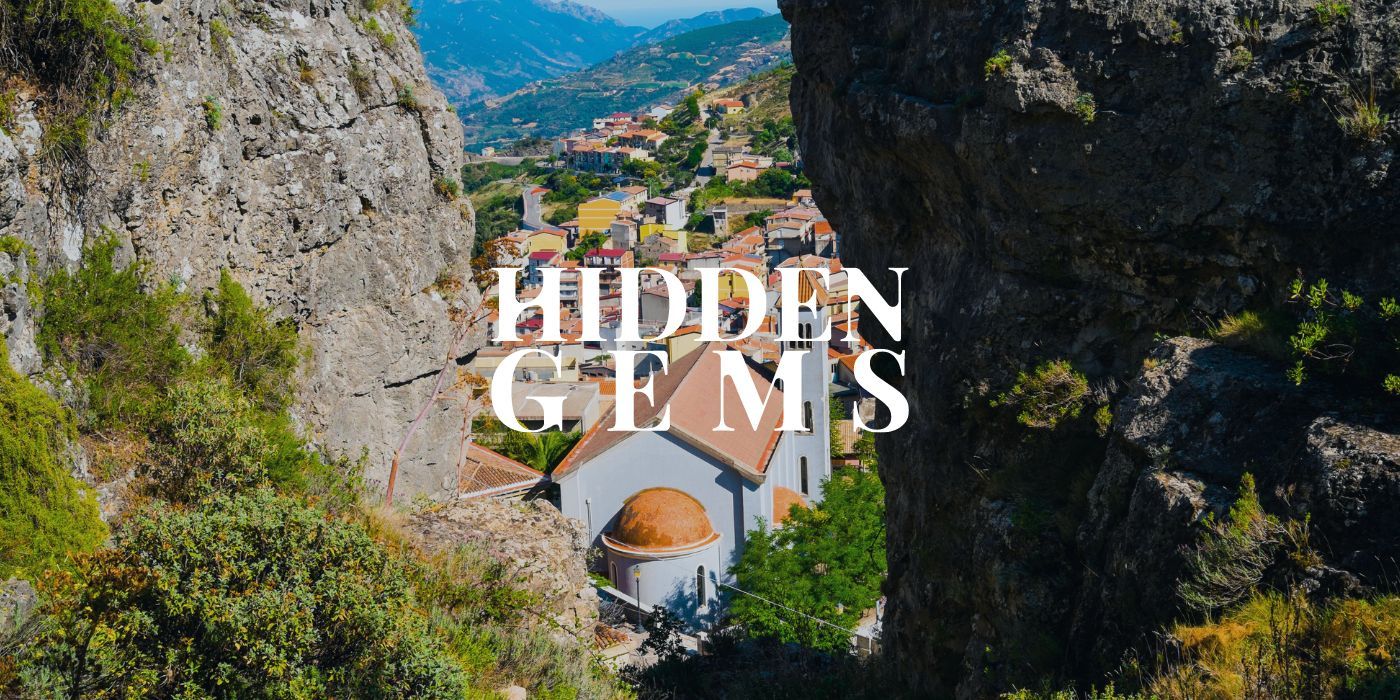
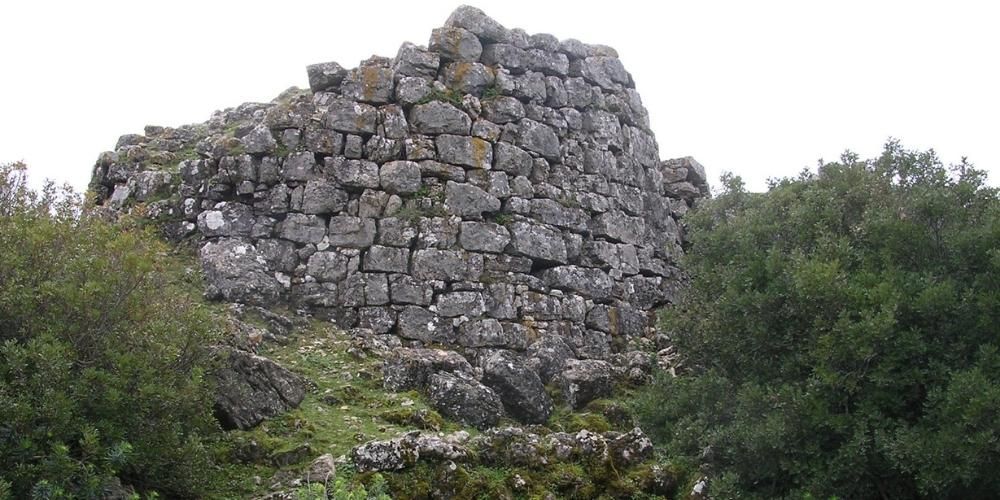
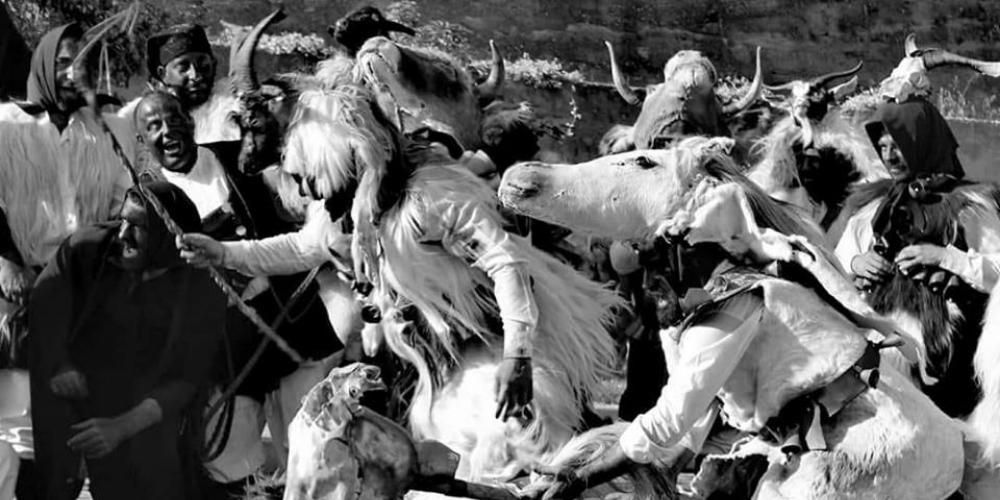
Chiara Musino
If you love discovering unusual unique places, here's what to do and see in Ulassai, a fantastic village icon of Ogliastra in the heart of Sardinia.